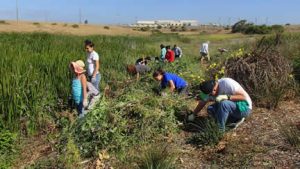Fourth Saturday Community Restoration Day

Growing the Next Generation of Grasslands
For the past seven years, Watsonville Wetlands Watch has been growing hundreds of pounds of native grass and wildflower seed for our native grassland restoration
This past month, students from the Pajaro Valley High School Green Careers class that we teach spent a day working in our native plant nursery and planting a new native grass and wildflower seed farm on the Pajaro Valley High School campus nature preserve. This work is important to our mission because the overlap of native grasslands and wetlands is critical to the nesting birds and wildlife that use the sloughs today, as well as the future generations of those species whose return we are working to support. Soon these plants will be producing the seeds for the next generation of Pajaro Valley grasslands and wildlife.
Caption: Green Careers student Antonio Hernandez leads the way in the planting of a new native seed farm on the Pajaro Valley High nature preserve.
Two Eaglets at Watsonville Slough
By Biologist and Environmental Consultant Gary Kittleson
On February 10, 2015 the Watsonville Sloughs’ resident pair of bald eagles began again their long, patient process of raising young. Bald eagles were first documented
Breeding bald eagles were absent for most of the last century in Central California after the eggshell thinning effects of DDT brought the species to near extinction. Once DDT’s ban went into effect, the Ventana Wildlife Society (VWS) began a major effort to reintroduce bald eagles in Central California. Between 1986 and 2000, researchers from the VWS released 70 juvenile bald eagles that were originally collected from wild nests in Alaska, Canada, and northern California.
The juvenile eagles were brought to Monterey County, raised to fledging size, and released from private land in Big Sur (now used as the California Condor release site) and from Lake San Antonio in southern Monterey County. The first bald eagle nests in the Central Coast were located in northern San Luis Obispo County in 1993. Since then, between 25 and 30 different bald eagle breeding territories have been established in Central California. Perhaps the most interesting part of the story is that the original “imported” juvenile eagles were released without parents to train them. Despite great odds, these young birds were ultimately successful in returning north, unguided, to Northwest Canada as juveniles to feed on the abundant salmon runs before coming back south, down the west coast to nest in Central California.
Photo by Gary Kittleson